stop start FIAT PUNTO 2020 Owner handbook (in English)
[x] Cancel search | Manufacturer: FIAT, Model Year: 2020, Model line: PUNTO, Model: FIAT PUNTO 2020Pages: 219, PDF Size: 9.82 MB
Page 165 of 219
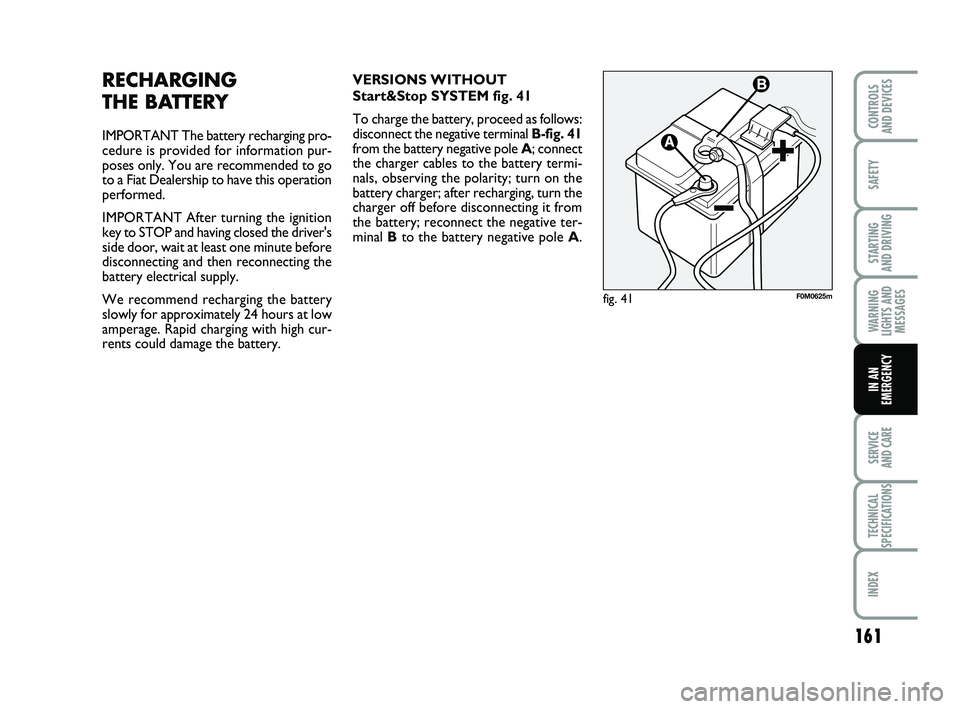
161
SAFETY
STARTING
AND DRIVING
WARNING
LIGHTS AND MESSAGES
SERVICE
AND CARE
TECHNICAL
SPECIFICATIONS
INDEX
CONTROLS
AND DEVICES
IN AN
EMERGENCY
RECHARGING
THE BATTERY
IMPORTANT The battery recharging pro-
cedure is provided for information pur-
poses only. You are recommended to go
to a Fiat Dealership to have this operation
performed.
IMPORTANT After turning the ignition
key to STOP and having closed the driver's
side door, wait at least one minute before
disconnecting and then reconnecting the
battery electrical supply.
We recommend recharging the battery
slowly for approximately 24 hours at low
amperage. Rapid charging with high cur-
rents could damage the battery. VERSIONS WITHOUT
Start&Stop SYSTEM fig. 41
To charge the battery, proceed as follows:
disconnect the negative terminal
B-fig. 41
from the battery negative pole A; connect
the charger cables to the battery termi-
nals, observing the polarity; turn on the
battery charger; after recharging, turn the
charger off before disconnecting it from
the battery; reconnect the negative ter-
minal Bto the battery negative pole A.
fig. 41F0M0625m
133-164 PUNTO POP 1ed EN 24/03/14 13:05 Pagina 161
Page 166 of 219
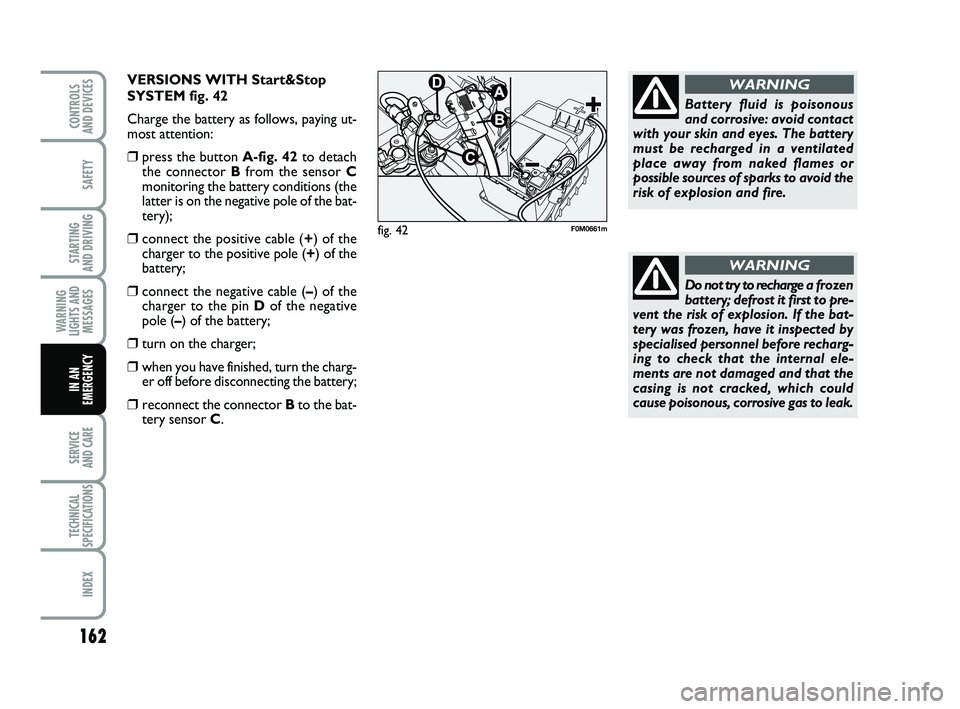
162
SAFETY
STARTING
AND DRIVING
WARNING
LIGHTS AND MESSAGES
SERVICE
AND CARE
TECHNICAL
SPECIFICATIONS
INDEX
CONTROLS
AND DEVICES
IN AN
EMERGENCY
Do not try to rechargea frozen
battery; defrost it first to pre-
vent the risk of explosion. If the bat-
tery was frozen, have it inspected by
specialised personnel before recharg-
ing to check that the internal ele-
ments are not damaged and that the
casing is not cracked, which could
cause poisonous, corrosive gas to leak.
WARNING
Battery fluid is poisonous
and corrosive: avoid contact
with your skin and eyes. The battery
must be recharged in a ventilated
place away from naked flames or
possible sources of sparks to avoid the
risk of explosion and fire.
WARNINGVERSIONS WITH Start&Stop
SYSTEM fig. 42
Charge the battery as follows, paying ut-
most attention:
❒press the button A-fig. 42 to detach
the connector B from the sensor C
monitoring the battery conditions (the
latter is on the negative pole of the bat-
tery);
❒connect the positive cable (+ ) of the
charger to the positive pole ( +) of the
battery;
❒connect the negative cable ( –) of the
charger to the pin D of the negative
pole ( –) of the battery;
❒turn on the charger;
❒when you have finished, turn the charg-
er off before disconnecting the battery;
❒reconnect the connector Bto the bat-
tery sensor C.
fig. 42F0M0661m
133-164 PUNTO POP 1ed EN 24/03/14 13:05 Pagina 162
Page 178 of 219

174
SAFETY
STARTING
AND DRIVING
WARNING
LIGHTS AND MESSAGES
IN AN
EMERGENCY
TECHNICAL
SPECIFICATIONS
INDEX
CONTROLS
AND DEVICES
SERVICE
AND CARE
If the oil level is close to or under MIN,
add oil through the filler neck A, until the
level reaches MAX.
The oil level should never exceed MAX.ENGINE OIL CONSUMPTION
The maximum engine oil consumption is
usually 400 grams every 1,000 km.
During the initial period of usage for the
vehicle, the engine is bedding in therefore
the engine oil consumption may settle
down only after the first 5,000-6,000 km.
IMPORTANT The oil consumption de-
pends on driving style and the conditions
under which the car is used.
IMPORTANT After adding or changing
the oil, let the engine turn over for a few
seconds and wait a few minutes after turn-
ing it off before you check the level.
ENGINE OIL fig. 5-6
Check the oil level a few minutes (about
5) after the engine has stopped, with the
car parked on level ground.
The oil level should be between the
MIN
and MAX marks on the dipstick B.
The gap between MIN and MAX is equal
to around 1 litre of oil.
fig. 5 – 1.2 and 1.4 8V versions F0M0149mfig. 6 – 1.3 Multijet versionF0M0150m
165-184 PUNTO POP 1ed EN 07/04/14 09:35 Pagina 174
Page 183 of 219
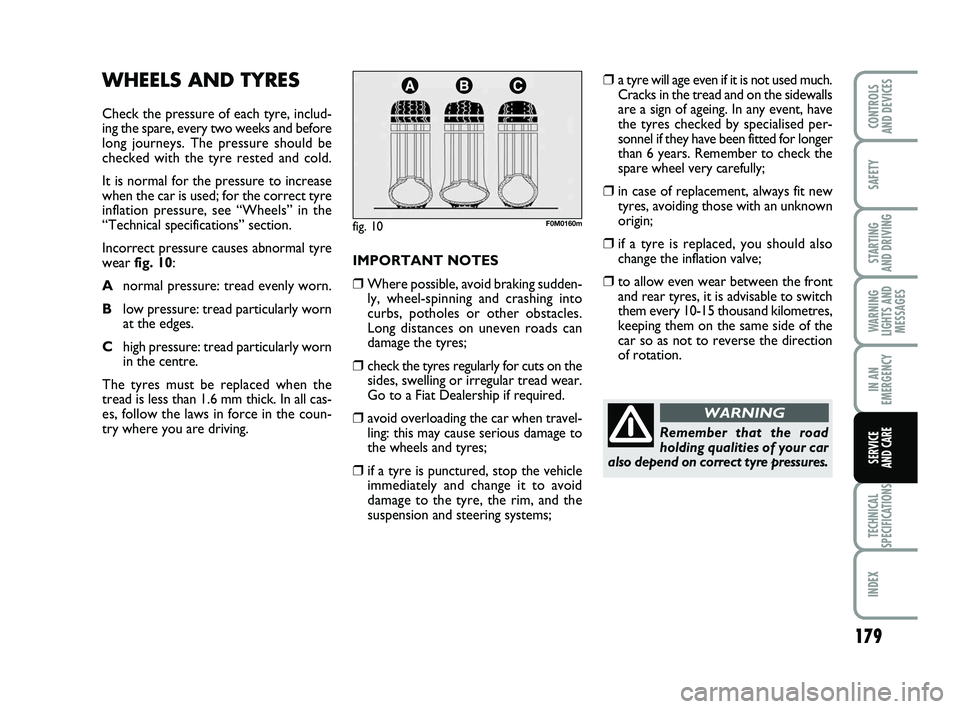
179
SAFETY
STARTING
AND DRIVING
WARNING
LIGHTS AND MESSAGES
IN AN
EMERGENCY
TECHNICAL
SPECIFICATIONS
INDEX
CONTROLS
AND DEVICES
SERVICE
AND CARE
WHEELS AND TYRES
Check the pressure of each tyre, includ-
ing the spare, every two weeks and before
long journeys. The pressure should be
checked with the tyre rested and cold.
It is normal for the pressure to increase
when the car is used; for the correct tyre
inflation pressure, see “Wheels” in the
“Technical specifications” section.
Incorrect pressure causes abnormal tyre
wear fig. 10:
A normal pressure: tread evenly worn.
B low pressure: tread particularly worn
at the edges.
C high pressure: tread particularly worn
in the centre.
The tyres must be replaced when the
tread is less than 1.6 mm thick. In all cas-
es, follow the laws in force in the coun-
try where you are driving.
fig. 10F0M0160m
IMPORTANT NOTES
❒Where possible, avoid braking sudden- ly, wheel-spinning and crashing into
curbs, potholes or other obstacles.
Long distances on uneven roads can
damage the tyres;
❒check the tyres regularly for cuts on thesides, swelling or irregular tread wear.
Go to a Fiat Dealership if required.
❒avoid overloading the car when travel-ling: this may cause serious damage to
the wheels and tyres;
❒if a tyre is punctured, stop the vehicleimmediately and change it to avoid
damage to the tyre, the rim, and the
suspension and steering systems;
❒a tyre will age even if it is not used much.Cracks in the tread and on the sidewalls
are a sign of ageing. In any event, have
the tyres checked by specialised per-
sonnel if they have been fitted for longer
than 6 years. Remember to check the
spare wheel very carefully;
❒in case of replacement, always fit newtyres, avoiding those with an unknown
origin;
❒if a tyre is replaced, you should alsochange the inflation valve;
❒to allow even wear between the front
and rear tyres, it is advisable to switch
them every 10-15 thousand kilometres,
keeping them on the same side of the
car so as not to reverse the direction
of rotation.
Remember that the road
holding qualities of your car
also depend on correct tyre pressures.
WARNING
165-184 PUNTO POP 1ed EN 07/04/14 09:35 Pagina 179
Page 187 of 219
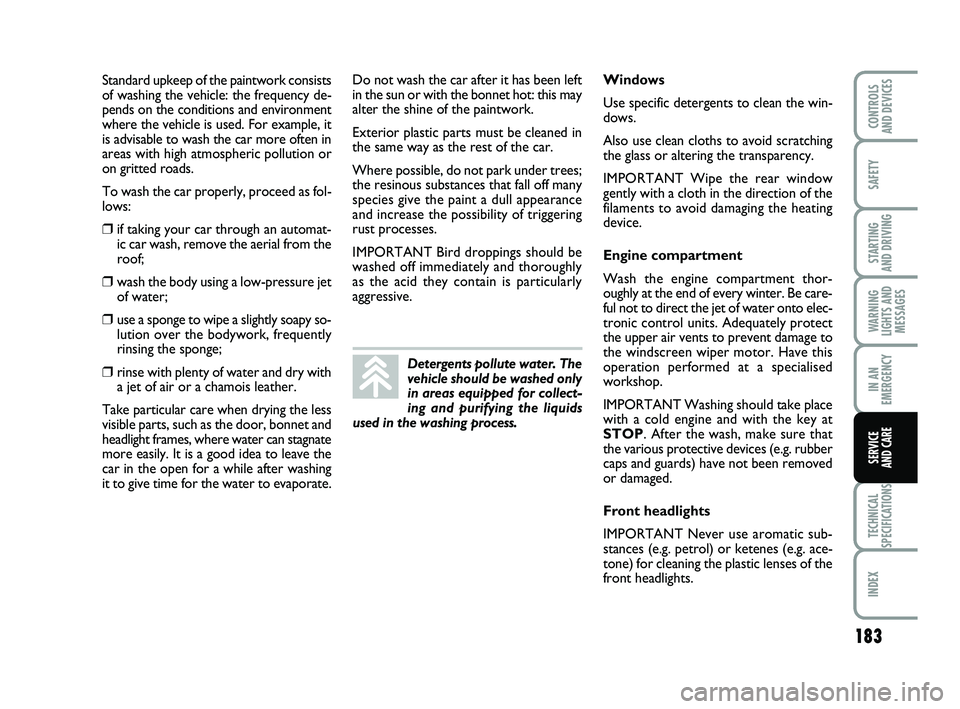
183
SAFETY
STARTING
AND DRIVING
WARNING
LIGHTS AND MESSAGES
IN AN
EMERGENCY
TECHNICAL
SPECIFICATIONS
INDEX
CONTROLS
AND DEVICES
SERVICE
AND CARE
Standard upkeep of the paintwork consists
of washing the vehicle: the frequency de-
pends on the conditions and environment
where the vehicle is used. For example, it
is advisable to wash the car more often in
areas with high atmospheric pollution or
on gritted roads.
To wash the car properly, proceed as fol-
lows:
❒if taking your car through an automat- ic car wash, remove the aerial from the
roof;
❒wash the body using a low-pressure jetof water;
❒use a sponge to wipe a slightly soapy so-lution over the bodywork, frequently
rinsing the sponge;
❒rinse with plenty of water and dry witha jet of air or a chamois leather.
Take particular care when drying the less
visible parts, such as the door, bonnet and
headlight frames, where water can stagnate
more easily. It is a good idea to leave the
car in the open for a while after washing
it to give time for the water to evaporate. Do not wash the car after it has been left
in the sun or with the bonnet hot: this may
alter the shine of the paintwork.
Exterior plastic parts must be cleaned in
the same way as the rest of the car.
Where possible, do not park under trees;
the resinous substances that fall off many
species give the paint a dull appearance
and increase the possibility of triggering
rust processes.
IMPORTANT Bird droppings should be
washed off immediately and thoroughly
as the acid they contain is particularly
aggressive.Detergents pollute water. The
vehicle should be washed only
in areas equipped for collect-
ing and purifying the liquids
used in the washing process.
Windows
Use specific detergents to clean the win-
dows.
Also use clean cloths to avoid scratching
the glass or altering the transparency.
IMPORTANT Wipe the rear window
gently with a cloth in the direction of the
filaments to avoid damaging the heating
device.
Engine compartment
Wash the engine compartment thor-
oughly at the end of every winter. Be care-
ful not to direct the jet of water onto elec-
tronic control units. Adequately protect
the upper air vents to prevent damage to
the windscreen wiper motor. Have this
operation performed at a specialised
workshop.
IMPORTANT Washing should take place
with a cold engine and with the key at
STOP. After the wash, make sure that
the various protective devices (e.g. rubber
caps and guards) have not been removed
or damaged.
Front headlights
IMPORTANT Never use aromatic sub-
stances (e.g. petrol) or ketenes (e.g. ace-
tone) for cleaning the plastic lenses of the
front headlights.
165-184 PUNTO POP 1ed EN 07/04/14 09:35 Pagina 183
Page 216 of 219
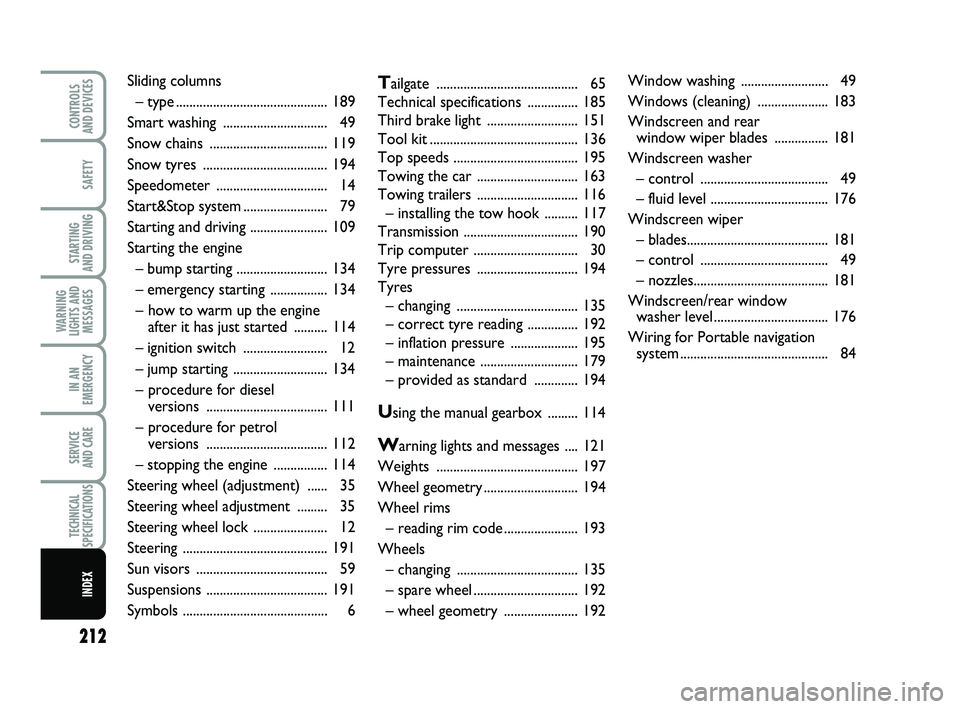
212
SAFETY
STARTING
AND DRIVING
WARNING
LIGHTS AND MESSAGES
IN AN
EMERGENCY
SERVICE
AND CARE
TECHNICAL
SPECIFICATIONS
INDEX
CONTROLS
AND DEVICES
Tailgate .......................................... 65
Technical specifications ............... 185
Third brake light ........................... 151
Tool ki t ............................................ 136
Top sp eeds ..................................... 195
Towing the car .............................. 163
Towing tra ilers .............................. 116
– installing the tow hook .......... 117
Transmission .................................. 190
Trip computer ............................... 30
Tyre press ures .............................. 194
Tyres – changing .................................... 135
– correct tyre reading ............... 192
– inflation pr essure .................... 195
– maintenance ............................. 179
– provided as standard ............. 194
Using the manual gearbox ......... 114
Warning lights and messages .... 121
Weights .......................................... 197
Wheel geom etry............................ 194
Wheel rims – reading rim code...................... 193
Wheels – changing .................................... 135
– spare wheel ............................... 192
– wheel geom etry ...................... 192 Window was
hing .......................... 49
Windows (cleaning) ..................... 183
Windscreen and rear window wiper blades ................ 181
Windscreen washer – control ...................................... 49
– fluid le vel ................................... 176
Windscreen wiper – blades .......................................... 181
– control ...................................... 49
– nozzles........................................ 181
Windscreen/rear window washer le vel.................................. 176
Wiring for Portable navigation system ............................................ 84
Sliding columns
– type ............................................. 189
Smart washing ............................... 49
Snow cha ins ................................... 119
Snow t yres ..................................... 194
Speedometer ................................. 14
Start&Stop system ......................... 79
Starting and driving ....................... 109
Starting the engine – bump starting ........................... 134
– emergency starting ................. 134
– how to warm up the engine after it has just started .......... 114
– ignition switch ......................... 12
– jump starting ............................ 134
– procedure for diesel versions .................................... 111
– procedure for petrol versions .................................... 112
– stopping the engine ................ 114
Steering wheel (ad justment) ...... 35
Steering wheel ad justment ......... 35
Steering wheel lock ......................
12
Steering ........................................... 191
Sun visors ....................................... 59
Suspensions .................................... 191
Symbols ........................................... 6
207-214 PUNTO POP 1ed EN 31/03/14 09:59 Pagina 212